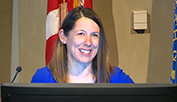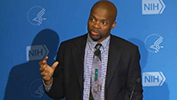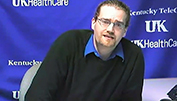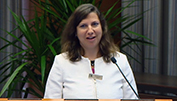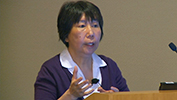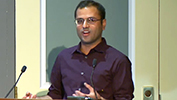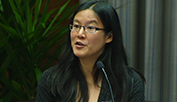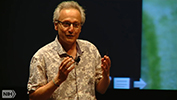-
- NIH VideoCast - Pragmatic Clinical Trials-Unique Opportunities for Disseminating, Implementing & Sustaining Evidence-Based Practices into Clinical Care
-
- - NIH (2017/05/26)
- - Category : Conferences
- Workshop will explore challenges and strategies for the dissemination, implementation and sustainability of pragmatic clinical trial findings. Pragmatic trials are distinct from more traditional clinical trials, as they are designed to assess the impact of interventions delivered in usual or real-world conditions. Moreover, performing pragmatic trials within fully integrated health care systems facilitates large-scale, efficient trials that leverage existing infrastructure to answer important clinical questions
NIH VideoCast - Pragmatic Clinical Trials-Unique Opportunities for Disseminating, Implementing & Sustaining Evidence-Based Practices into Clinical Care
-
- NIH VideoCast - CC Grand Rounds: 1) New Magnetic Resonance Imaging (MRI)-based Diagnostic Approaches to Multiple Sclerosis and 2) Strategies for the Development of Rational Therapeutic Approaches in Multiple Sclerosis
-
- - Daniel S. Reich, MD, PhD, Chief, Translational Neuroradiology Section, Division of Neuroimmunology and Neurovirology, NINDS, NIH and 2) Peter Calabresi, MD, Director, Division of Neuroimmunology and Neuro-infectious Diseases and Professor of Neurology, Johns Hopkins University School of Medicine (2017/05/26)
- - Category : Clinical Center Grand Rounds
- CC Grand Rounds: 1) New Magnetic Resonance Imaging (MRI)-based Diagnostic Approaches to Multiple Sclerosis and 2) New Magnetic Resonance Imaging (MRI)-based Diagnostic Approaches to Multiple Sclerosis
For more information go to http://www.cc.nih.gov/about/news/grcurrent.html
NIH VideoCast - CC Grand Rounds: 1) New Magnetic Resonance Imaging (MRI)-based Diagnostic Approaches to Multiple Sclerosis and 2) Strategies for the Development of Rational Therapeutic Approaches in Multiple Sclerosis
-
- NIH VideoCast - How aneuploidy drives cancer
-
- - Stephen J. Elledge, Ph.D., Gregor Mendel Professor of Genetics and Medicine at Harvard Medical School; Geneticist, Department of Medicine, Brigham and Women`s Hospital; Investigator, Howard Hughes Medical Institute (2017/05/26)
- - Category : WALS - Wednesday Afternoon Lectures
- NIH Director`s Wednesday Afternoon Lecture Series
Aneuploidy has been recognized as a hallmark of cancer for more than 100 years, yet no general theory has emerged to explain the recurring patterns of aneuploidy in cancer. Dr. Elledge`s laboratory developed the Tumor Suppressor and Oncogene (TUSON) Explorer, a computational method that analyzes the patterns of mutational signatures in tumors and predicts the likelihood that any individual gene functions as a tumor suppressor gene (TSG) or an oncogene (OG). By analyzing more than 8,200 tumor-normal pairs, his lab has provided statistical evidence suggesting that many more genes possess cancer-driver properties than anticipated, forming a continuum of oncogenic potential. These genes represent the vast majority of cancer drivers, and the genetic networks they drive are a focus of future cancer system-biological approaches to cancer research. By integrating the driver predictions with information on somatic copy-number alterations, his lab has found that the distribution and the potency of TSGs (STOP genes), OGs, and essential genes (GO genes) on chromosomes can predict the complex patterns of aneuploidy and copy-number variation characteristic of cancer genomes. The lab proposes that the cancer genome is shaped through a process of cumulative haploinsufficiency and triplosensitivity. Dr. Elledge and his lab are now assessing how aneuploidy drives cancer and the potency with which it does so. They have found that, in many cases, aneuploidy predicts survival better than do mutational drivers or existing clinical parameters. They have also discovered that different classes of aneuploidy drive transcriptional programs for two hallmarks of cancer. Aneuploidy promotes a cell-proliferation program and inhibits the infiltration of immune cells leading to immune evasion. Melanoma patients with tumors exhibiting high aneuploidy show poorer responses to immunotherapy with anti-CTLA4 antibodies. Dr. Elledge and his lab are now exploring which genes in recurring amplicons drive proliferation.
For more information go to https://oir.nih.gov/wals/2016-2017
NIH VideoCast - How aneuploidy drives cancer
-
- NIH VideoCast - Myeloid-derived Trefoil Factor 2 (TFF2) controls epithelial regeneration at the mucosal interface
-
- - De???Broski Herbert Ph.D., Associate Professor of Immunology, University of Pennsylvania School of Veterinary Medicine (2017/05/26)
- - Category : Immunology
- Immunology Interest Group Seminar Series
Trefoil factor proteins, an enigmatic family of mucosal cytokines, are known to promote tissue repair. Despite being discovered decades ago, not much was known until recently about how Trefoil proteins work. Dr. Herbert???s laboratory has discovered that these proteins regulate immune responses in allergic asthma and hookworm infection, and that they trigger the regeneration of epithelial cells.
De???Broski Herbert is an Associate Professor of Immunology at the University of Pennsylvania School of Veterinary Medicine. He received his B.S. in microbiology from Xavier University in New Orleans, and his Ph.D. in immunology from Thomas Jefferson University in Philadelphia. De???Broski received a Colin Powell Tropical Disease Postdoctoral Fellowship to research infectious immunology at the University of Cape Town in South Africa. In 2007, he received his first NIH-RO1 and became a tenure track faculty member at the University of Cincinnati/Cincinnati Children???s Hospital starting in 2009. He was recruited to the University of California at San Francisco in 2012 where he was promoted to the rank of Associate Professor. He relocated his lab to UPenn in 2016. De???Broski has made numerous important contributions to our understanding of the regulatory networks that control immunity, inflammation, and tissue repair at mucosal surfaces. He has characterized roles for intestinal epithelia in driving type 2 host immunity against gastrointestinal worms and for alternatively activated macrophages in regulating intestinal immunopathology.
NIH VideoCast - Myeloid-derived Trefoil Factor 2 (TFF2) controls epithelial regeneration at the mucosal interface
-
- NIH VideoCast - Oncogenic herpesvirus hijacks components of the DNA repair machinery to promote its own replication
-
- - Dr. Xiaofan Li, State University of New York, Stony Brook, NY (2017/05/25)
- - Category : DNA Repair
- DNA repair videoconference
Young Investigator Showcase
Acrobat Slides
NIH VideoCast - Oncogenic herpesvirus hijacks components of the DNA repair machinery to promote its own replication
-
- NIH VideoCast - Regulation of melanocyte DNA repair by the melanocortin signaling axis
-
- - Dr. Stuart Jarrett, University of Kentucky (2017/05/25)
- - Category : DNA Repair
- DNA repair videoconference
Young Investigator Showcase
Acrobat Slides
NIH VideoCast - Regulation of melanocyte DNA repair by the melanocortin signaling axis
-
- NIH VideoCast - National Advisory Dental and Craniofacial - May 2017
-
- - NIDCR, NIH (2017/05/25)
- - Category : Advisory Board Meetings and Workshops
- The mission of the National Institute of Dental and Craniofacial Research (NIDCR) includes the support of basic, clinical and translational research as well as the support of research training and the development of research careers. To help achieve the goals of the NIDCR, the National Advisory Dental and Craniofacial Research Council (NADCRC) has the responsibility of advising, consulting with and making recommendations to the Secretary, DHHS, and the Director, NIDCR, on matters relating to the directions of research, research support, training and career development supported by the Institute. Included in this responsibility is the conduct of the secondary review of research grant applications with a focus on NIDCR scientific program priorities and program balance as well as the conduct of research by the Division of Intramural Research, NIDCR.
NIH VideoCast - National Advisory Dental and Craniofacial - May 2017
-
- NIH VideoCast - Vivian Pinn Symposium 2017 - Healthy Women Make Healthy Communities: Women as Makers
-
- - Office of Research on Women???s Health, NIH (2017/05/24)
- - Category : Conferences
- 2nd Annual Vivian Pinn Symposium
The NIH Vivian W. Pinn Symposium was established in recognition of Dr. Vivian W. Pinn???s longstanding leadership in women???s health research. Throughout her 20-year career as director of the Office of Research on Women???s Health, Dr. Pinn led NIH efforts to implement and monitor the inclusion of women and minorities in clinical research funded by NIH. The annual seminars are held during National Women???s Health Week and feature key topics and speakers relevant to scientific audiences or the general public. This year???s panel will address multiple domains that influence the health of women in the United States, draw relationships to larger contexts of families and communities, and highlight issues related to the experiences that affect women???s health.
Dr. Ana Langer, Professor of the Practice of Public Health and Director of the Women and Health Initiative at the Harvard T.H. Chan School of Public Health at Harvard University, is respected worldwide as a leader in using research findings to influence policy and improve the overall quality of health care for women and families. For more than 25 years, she has been a leading researcher, programmer, and advocate for the improvement of women???s health.
Dr. Afaf Ibrahim Meleis is Professor of Nursing and Sociology and Dean Emerita of the School of Nursing at the University of Pennsylvania. Through mentorship and research, she advanced transitions theory, which focuses on assisting nurses in facilitating patients???, families???, and communities??? healthy transitions. Her work has been translated globally into policy, research, and evidence-based practice.
Dr. Jennifer Montez, Assistant Professor of Sociology and Gerald B. Cramer Faculty Scholar of Aging Studies at Syracuse University, studies inequalities in adult mortality across education levels and geographic areas within the United States. She is particularly interested in why the growing inequalities have been most troublesome among women. Her current work on this topic blends perspectives from social demography and feminist geography to investigate the role of states in shaping women???s and men???s mortality in unique ways.
NIH VideoCast - Vivian Pinn Symposium 2017 - Healthy Women Make Healthy Communities: Women as Makers
-
- NIH VideoCast - NIH Pi Day (rescheduled): PiCo Lightning Talks
-
- - NIH (2017/05/24)
- - Category : Special
- (RESCHEDULED FROM MARCH 14, 2017)
NIH Pi Day 2017: PiCo Lightning Talks
PiCo Lightning Talks
These talks are structured lightning talks consisting of 3 slides to share 1 idea in 4 minutes (a clear reference to Pi, 3.14???). Presenters will represent a variety of NIH Institutes and Centers.
For more information on NIH Pi Day, go to https://datascience.nih.gov/news-events
For more information go to http://nihpiday.nih.gov
NIH VideoCast - NIH Pi Day (rescheduled): PiCo Lightning Talks
-
- NIH VideoCast - NIH Pi Day (rescheduled): Data Science Lecture - The Mathematics of Biomedical Data Science
-
- - Dr. Bonnie Berger, Simons Professor of Mathematics, MIT (2017/05/24)
- - Category : Special
- (RESCHEDULED FROM MARCH 14, 2017)
NIH Pi Day 2017: Data Science Distinguished Seminar Series Lecture, ???The Mathematics of Biomedical Data Science???
Data Science Distinguished Seminar Series, 1:00-2:00 PM. Lecture by Simons Professor of Mathematics at MIT, Dr. Bonnie Berger, ???The Mathematics of Biomedical Data Science.???
The last two decades have seen an exponential increase in genomic and biomedical data, which are outstripping advances in computing power. Extracting new science from these massive datasets will require not only faster computers; it will require algorithms that scale sublinearly in the size of the datasets. We introduce a novel class of algorithms that are able to scale with the entropy and low fractal dimension of the dataset by taking advantage of the unique structure of massive biological data to operate directly on compressed data. These algorithms can be used to address large-scale challenges in genomics, metagenomics and chemogenomics. For more information on NIH Pi Day, go to https://datascience.nih.gov/news-events
For more information go to https://nihpiday.nih.gov
NIH VideoCast - NIH Pi Day (rescheduled): Data Science Lecture - The Mathematics of Biomedical Data Science
-
- NIH VideoCast - Defining and Generating Neuronal Diversity Using Reprogramming
-
- - Kristin Baldwin, Ph.D., Associate Professor, Department of Molecular & Cellular Neuroscience, The Scrippts Research Insitutue, CA (2017/05/24)
- - Category : Neuroscience
- NIH Neuroscience Series Seminar
Dr. Baldwin???s lab is interested in understanding how genetic and epigenetic changes generate cellular diversity, with a particular focus on neurons of the olfactory system and central nervous system. They employ stem cell technologies such as cloning and induced pluripotency, gene targeting in mice, molecular biology and advanced imaging techniques to identify rules governing cell identity and cellular diversification. They are also interested in using induced pluripotent stem cells and neurons derived from them to generate in vitro models of human neurological diseases.
Their current research focus includes 1) Generating Mice from iPS Cells; 2) Control of genome stability during reprogramming and in iPSCs; 3) Generating Cell Lines from Neurons; 4) Modeling Neurological Disease Using Reprogramming; 5) Generating Neuronal Diversity and Connectivity in the Olfactory System.
For more information go to https://neuroscience.nih.gov/neuroseries/Home.aspx
NIH VideoCast - Defining and Generating Neuronal Diversity Using Reprogramming
-
- NIH VideoCast - NIDCD Beyond the Lab, Understanding Communication Disorders: The Making of the Inner Ear
-
- - Doris K. Wu, Ph.D., Chief, Laboratory of Molecular Biology and Section on Sensory Cell Regeneration and Development, NIDCD, NIH (2017/05/24)
- - Category : Special
- NIDCD Beyond the Lab, Understanding Communication Disorders Speaker Series
Designed for administrative and support staff as well as scientists, the Beyond the Lab, Understanding Communication Disorders speaker series gives the NIH community an opportunity to learn about the National Institute on Deafness and Other Communication Disorder???s (NIDCD) research and research advances.
Our ability to hear and maintain our balance relies on thousands of sensory cells (called hair cells) in the inner ear. The NIDCD Laboratory of Molecular Biology is working to identify the molecules that are important in directing the development of hair cells and the formation of the inner ear.
NIH VideoCast - NIDCD Beyond the Lab, Understanding Communication Disorders: The Making of the Inner Ear
-
- NIH VideoCast - Pushing the envelope in biological microscopy: High speed imaging at and beyond the diffraction limit
-
- - Hari Shroff, Ph.D, Senior Investigator, NIBIB, NIH (2017/05/23)
- - Category : NIH Director`s Seminars
- Director`s Seminar Series
Dr. Hari Shroff will discuss his lab`s, the Section of High Resolution Optical Imaging (HROS), efforts to improve structured illumination microscopy (SIM) and light-sheet microscopy. SIM doubles the spatial resolution of light microscopy, requiring lower light intensities and acquisition times than other super-resolution techniques. Dr. Shroff will present SIM implementations that enable resolution doubling in live samples > 10-20x thicker than possible with conventional SIM, as well as hardware modifications that enable effectively ???instant??? SIM imaging at rates 10-100x faster than other SIM. New applications of instant SIM, including combination with total internal reflection (TIRF) and with adaptive optics will also be discussed.
The second half of the talk will focus on the development of inverted selective plane illumination microscopy (iSPIM), and subsequent application to the noninvasive study of neurodevelopment in nematodes. Dr. Shroff will discuss progress that quadruples the axial resolution of iSPIM by using a second specimen view, enabling imaging with isotropic spatial resolution (dual-view iSPIM, or diSPIM). Newer multiview microscopes with more objectives and more views, further improving spatial resolution, will also be described. Applications of these technologies will be presented, including computational methods for untwisting worm embryos and calcium imaging in freely moving embryos. Finally, Dr. Shroff will discuss the current status of the new trans-NIH, advanced imaging and microscopy (AIM) facility which allows intramural researchers to use cutting edge optical imaging systems developed at NIH.
NIH VideoCast - Pushing the envelope in biological microscopy: High speed imaging at and beyond the diffraction limit
-
- NIH VideoCast - HHS FAPAC Forum - May 2017
-
- - HHS and FAPAC (2017/05/19)
- - Category : Asian/Pacific Islander
- HHS and FAPAC Pre-Conference Agency Forum & Asian American and Pacific Islander Heritage Month Observance. The 32nd National Leadership Training Program & Exhibits. Theme: Unite our Voices by Speaking Together. Forum objectives: 1) To address new challenges and new opportunities on diversity and inclusion. 2) To address the challenges, interest and concerns of AAPI workforce within HHS
NIH VideoCast - HHS FAPAC Forum - May 2017
-
- NIH VideoCast - NIA NACA Council - May 2017
-
- - NIA, NIH (2017/05/19)
- - Category : Advisory Board Meetings and Workshops
- The National Advisory Council on Aging (NACA) advises the Secretary of the U.S. Department of Health and Human Services, the Director of NIH, and the Director of NIA on its mission. The Council meets three times a year to consider applications for research and training.
NIH VideoCast - NIA NACA Council - May 2017
-
- NIH VideoCast - CC Grand Rounds: 1) New Concepts in Nitric Oxide (NO) Formation and Function in the Human Vasculature and 2) Therapeutic Bioengineering of Heme-globins as Nitrite Reductases and CO Scavenging Molecules
-
- - Alan N. Schechter, MD Chief, Molecular Medicine Branch, NIDDK, NIH and Mark T. Gladwin, MD, Jack D. Myers Professor and Chair, Department of Medicine, Director, Pittsburgh Heart, Lung, and Blood Vascular Medicine Institute, University of Pittsburgh Medical Center and the University of Pittsburgh School of Medicine (2017/05/19)
- - Category : Clinical Center Grand Rounds
- CC Grand Rounds: 1) New Concepts in Nitric Oxide (NO) Formation and Function in the Human Vasculature and 2) Therapeutic Bioengineering of Heme-globins as Nitrite Reductases and CO Scavenging Molecules
For more information go to http://www.cc.nih.gov/about/news/grcurrent.html
NIH VideoCast - CC Grand Rounds: 1) New Concepts in Nitric Oxide (NO) Formation and Function in the Human Vasculature and 2) Therapeutic Bioengineering of Heme-globins as Nitrite Reductases and CO Scavenging Molecules
-
- NIH VideoCast - John Daly Lecture: From the Jungle to the Synchrotron - Seven Millennia of Discovering Medicines Targeting G Protein-coupled Receptors
-
- - Dr. Fiona Marshall, Founder, Director, and Chief Scientific Officer Heptares Therapeutics Ltd, Hertfordshire, UK (2017/05/19)
- - Category : Special
- John Daly Lecture 2017
G protein-coupled receptors (GPCRs) are the largest family of related proteins in the human body and the site of action of around 300f prescription drugs. Drugs that target GPCRs derived from plants such as opioids, cannabinoids and alkaloids have been used as medicines for thousands of years without an understanding of their mechanism of action. Today advances in X-ray crystallography and biophysics are changing the face of GPCR drug discovery, enabling a precise understanding of the mechanisms of action of these drugs. GPCR x-ray structures are revealing an unexpected diversity in allosteric binding sites found on receptors and open up new opportunities for drug design. This lecture will provide an introduction to GPCRs, including some of the history of GPCR drug discovery finishing with an up-to-date description of the latest developments in our understanding of GPCR structures and their use in structure-based drug discovery.
Dr. Marshall will deliver her lecture in memory of Dr. John Daly, a noted natural products chemist and pharmacologist in NIDDK.
NIH VideoCast - John Daly Lecture: From the Jungle to the Synchrotron - Seven Millennia of Discovering Medicines Targeting G Protein-coupled Receptors
-
- NIH VideoCast - Brave new world: recent evolution of an insect-transmitted pathogen
-
- - Roberto Kolter, Ph.D., Professor of Microbiology and Immunobiology, Harvard Medical School (2017/05/19)
- - Category : WALS - Wednesday Afternoon Lectures
- NIH Director`s Wednesday Afternoon Lecture Series
Any population of organisms, be it made up of animals or plants, is susceptible to invasion by pathogens. Moreover, human-population migration, habitat simplification, and domestication of plants and animals have created novel ecological niches. Some pathogens are able to emerge into these niches and cause diseases that threaten public health and agricultural production. Despite the fact that such pathogens are common, there is often a lack of detailed studies that track their evolutionary origin and the effects of the population`s ecological community structure on pathogen virulence, transmission, and epidemic persistence.
For his lecture, Dr. Kolter will discuss the studies his lab is carrying out to understand the evolution and ecology of a fatal bacterial wilt disease transmitted by the striped cucumber beetle (Acalymma vittatum) and caused by the bacterium Erwinia tracheiphila. This bacterial wilt disease is an annual epidemic of cucurbit crop populations (squashes, cucumbers, etc.) that is geographically restricted to plants grown in the temperate zones of the Northeastern and Midwestern United States. Dr. Kolter`s laboratory results suggest that the pathogen evolved relatively recently, and the disease gained epidemic proportions as a consequence of Old World hypersusceptible cucurbits (cucumbers, melons) being introduced into North America and the unique ecology of the affected areas.
For more information go to https://oir.nih.gov/wals/2016-2017
NIH VideoCast - Brave new world: recent evolution of an insect-transmitted pathogen
-
- NIH VideoCast - Pathways for Successful Translation of New Imaging Agents and Modalities
-
- - NCI, NIH (2017/05/18)
- - Category : Conferences
- The Cancer Imaging Program at NCI is hosting a workshop on Monday May 15th, to discuss phase III trial designs for novel oncologic imaging agents and modalities, for clinical, regulatory and reimbursement endpoints.
NIH VideoCast - Pathways for Successful Translation of New Imaging Agents and Modalities
-
- NIH VideoCast - Anita Roberts Lecture: The hidden secrets of small genes
-
- - Gisela Storz, Ph.D., Head, Section on Environmental Gene Regulation, Eunice Kennedy Shriver National Institute of Child Health and Human Development, NIH (2017/05/18)
- - Category : Anita B. Roberts - Distinguished Women Scientists
- Women Scientists Advisory WSA
Anita Roberts Lecture
The hidden secrets of small genes
One major focus of our research has been the identification and characterization of small, regulatory RNAs in E. coli. Similar to eukaryotic miRNAs, many of these bacterial RNAs act by base pairing with mRNA targets to modulate mRNA stability and translation and are integral to most regulatory networks. Interestingly, while it was initially assumed these small RNAs are encoded as independent genes, recent studies have shown that many small RNAs are derived from the 3??? end of protein coding genes and the distinction between coding and noncoding is becoming increasingly blurred. A second major focus is the identification and characterization of small proteins of less than 50 amino acids, another overlooked class of biological molecules. Recent studies show that a major function of these small proteins, in both bacteria and eukaryotes, is regulating transporters and other large proteins in the membrane.
NIH VideoCast - Anita Roberts Lecture: The hidden secrets of small genes



